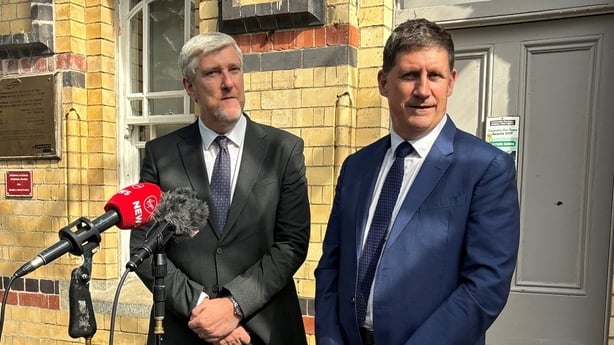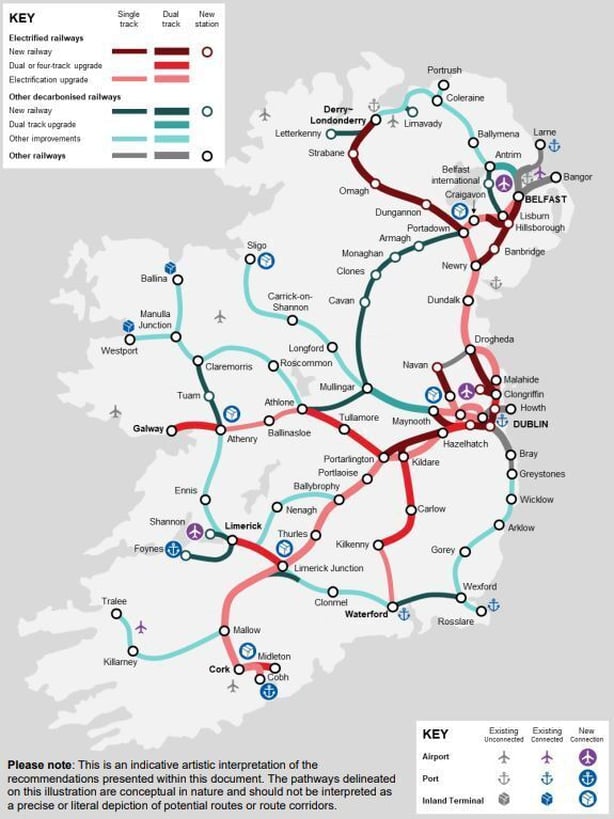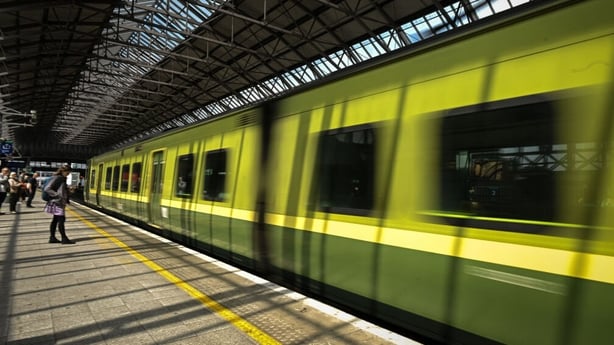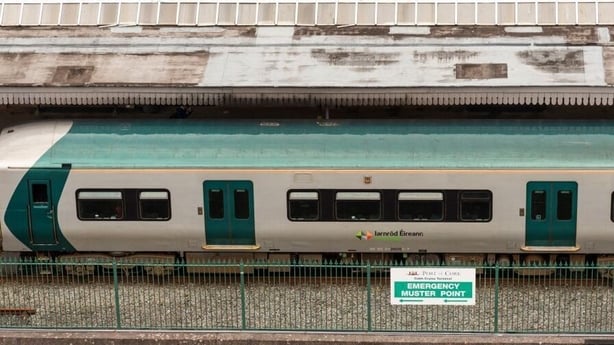Once upon a time, around 100 years ago, Ireland had a more extensive rail network than it does today.
Minister for Transport Eamon Ryan said that we had "the best rail service in the world back in 1920" - a network that we built ourselves.
Then, it was more than 5,000km long. Today, it's around half that.
But that could all change, if proposals to transform rail travel on the island of Ireland is implemented.
That plan though, as it is set out, would take 26 years from today, up to 2050, at a cost of between €35 and €37 billion in 2023 terms.
The All-Island Strategic Rail Review's final report was published this week.
It aims to correct an imbalance in regional development and outlines how the network could be upgraded and expanded to deliver faster, more frequent services that have more capacity, while reducing carbon emissions.
It also seeks to bring trains to parts of the island that have been neglected by rail for many decades.
It's a big, expensive vision for the future and those looking at this plan might wonder how much of it can be achieved.
Overall, the ambition is to electrify much of the network, upgrade single tracks to doubles, and in some cases four tracks, increase speed and frequency and reduce journey times.
Some of it could be delivered in the next six years, if the funding is there.

These short-term changes could include hourly intercity services between Dublin and Belfast, Cork, Limerick, Galway and Waterford.
Building the Limerick to Foynes railway and starting to reinstate previous routes from Claremorris to Athenry and Antrim to Lisburn are also in vision up to 2030.
While it will take time and money, building on what is already there in terms of physical rail infrastructure and services, will be the easy part.
The transformative work of laying tracks from scratch in parts of the country like the north midlands and north west, however, will be more complicated, more costly and take more time.
Minister Ryan said a plan to build a line from Portadown to Letterkenny, via Dungannon, Omagh and Derry, was one of the most "inspiring" parts of the proposals.
After all, many would say the north west has been neglected in terms of investment in infrastructure over the years.
Apart from serving people living in big towns along the way, it would open up that part of the island to all sorts of economic benefits, not least tourism, by allowing visitors access one of our most popular destinations, Donegal, by rail.
To make this vision for the north west a reality will take "several billions" to deliver.
Starting this project could happen in the medium term, but its completion falls into the "long term" bracket, between 2040 and 2050.
People living in the border counties of Cavan and Monaghan will be pleased to see their inclusion in this plan, after losing services in the 1950s.
The vision sets out a route through Cavan, Clones and Monaghan town, on a line stretching from Mullingar to Armagh.
It would connect that part of the north east with all other major routes, once a new line is built between Mullingar and Athlone.
But it could be almost a century-long wait for the return of rail there, because that part of the vision is also in the long term.

One major town with a very active campaign to bring back trains is Navan in Co Meath.
In an expanded commuter belt, Navan and surrounding areas have experienced significant population growth, and many of those who live in the town leave the county every day to travel to Dublin for work or education.
The Navan rail line is already part of the Greater Dublin Area Transport Strategy and is expected to be delivered after 2030, but under this strategic review, other measures that would support the delivery of DART commuter services to Navan are included.
Indeed, some measures both in this vision, and in the "spirit" of this vision are already in train.
For instance, an hourly service on the Enterprise service between Belfast and Dublin is scheduled to commence by October.
The DART+ West project to extend services to Kildare and Meath received planning permission just this week.
It will bring the DART from Connolly/Spencer Dock in north Dublin to Maynooth in Kildare, and on to the M3 Parkway at Dunboyne in Co Meath.
Work is also ongoing to bring the DART to Drogheda in Co Louth. This would increase hourly capacity and frequency on the northern commuter route.
This is also the route that will get the first electric trains. They're due to be delivered this September, but won’t come into use until 2026, and the full electrification of the Dublin to Belfast route is expected to take place in the early 2030s.
Whether it’s short, medium or long term in vision, those central to this plan say it’s a good start.

CEO of Iarnród Éireann Jim Meade said that "pieces of the puzzle are already in play" and, over time, the public will see an enhanced public transport network.
Selecting which projects to start with is a process that’s already under way, in consultation with the Department of Transport, working with the European Investment Bank.
"We do need to phase this out over the next 20 years and identify those critical projects and get moving on those. When we finish that process in the autumn we will have a list of critical projects we want to work on straight away," Mr Meade said.
The process, he added, will lay out timelines and allow the company to "identify the projects we can do now that will build into the overall vision".
This document provides a framework, but for it to be implemented, it requires two more things: money and political will.
At an estimated total cost of up to €37bn, where is this money going to come from?
That’s €1.5bn per year from the Irish Government, and Minister Ryan says it comes from the Exchequer.
He pointed to investment in rail that’s already ongoing.
"It's happening all over the place, we are investing. The question is 'what next?'. We know we need €1.5bn a year, it's not small money, but that's what we're going to put to Government." the minister said.
€7bn will have to come from Northern Ireland’s coffers.
Infrastructure Minister John O’Dowd said it would be very difficult to forecast what the economy would look like over a period of 25 years, but that "delay is your enemy".
"We can’t afford not to do it. This is about our economy, correcting regional imbalance and this is about tackling climate change."
Mr O'Dowd said he was dealing with a "very difficult budget" in Northern Ireland.
"But we do have money and it’s how you use that funding which is important. I intend to use my period in office and the limited budget I have to invest in the economy moving forward. Yes, there are huge challenges ahead, but there are also huge opportunities if the right political decisions are made," he added.

It’s possible, also, that the Shared Island Fund, which is already contributing to cross-border transport and other projects, could be used for this grand railway plan.
"We’ll have to continue to look at that", said Eamon Ryan.
He thinks implementing what’s in this report is "doable", but will require political decisions.
This means increasing the overall capital budget for transport.
"That’s the political question of our time. Are the other parties willing to prioritise public transport and give the money? I think the answer will be yes," he said.
It will be for successive governments over the coming decades to decide on how to implement this report and invest in the rail network.
Whether the Green Party is there or not next time around, it won’t be a decision for Mr Ryan, as the former leader has already announced that he won’t be running in the next general election.
This week, he put it up to whoever will be in the next government to deliver this transformational public transport system.
"I say to every political party now, show us your colours, tell us what you intend. Do you intend to invest in public transport or do you intend scrapping?
"Which one would you scrap? Would you get rid of the Limerick metropolitan rail or the Cork metropolitan rail? Would you not build the Western Rail Corridor or the light rail in Galway? I would build it, and that's a political choice.
"We have the arguments on our side now, we have the analysis, the strategy and policy work done, it's down to political decisions."







